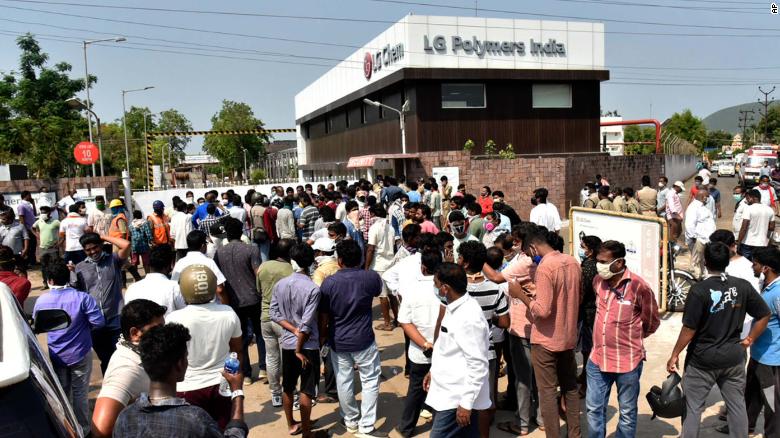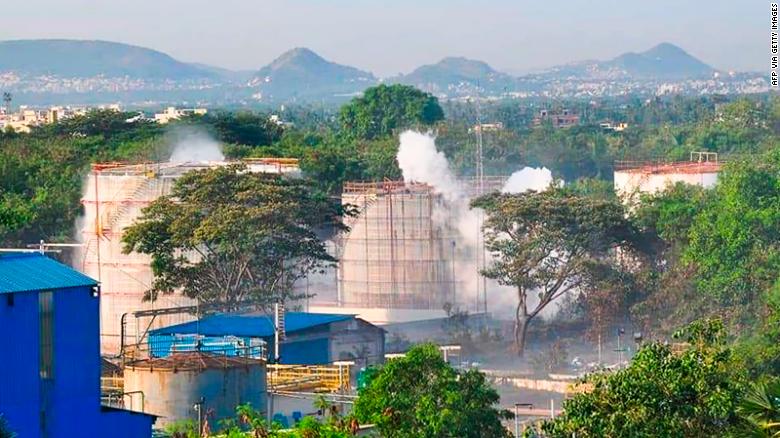India: Disaster on Disaster
"When we arrived on the spot a lot of people were lying on the ground unconscious and we evacuated around 1,000 people and rushed them to the hospital."
Tej Bharath, senior Vishakhapatnam district official.
"We couldn't immediately enter because the smell of the gas was very pungent so we had to wait for half an hour before we could go in and start evacuating people."
K Kanna Babu, managing director, state's disaster response force
"[We] are currently assessing local town residents' damage situation and are taking maximum necessary measures for the protection of residents and employees together with related organizations.""The factory's gas leak is currently under control. Leaked gas can cause vomiting and dizziness from inhaling. [We] are seeking all measures so that related treatment can be done quickly."LG Chem statement"There is no specific antidote to reverse the effect of Styrene.""The treatment does remain mainly supportive. Individuals have to be removed from the exposed area."Dr. Randeep Guleria, Director, All India Institute of Medical Sciences
 |
| A man runs carrying a child affected by a chemical gas leak in Vishakhapatnam, India, Thursday, May 7, 2020. Chemical gas leaked from an industrial plant in southern India early Thursday, leaving people struggling to breathe and collapsing in the streets as they tried to flee. Administrator Vinay Chand said several people fainted on the road and were rushed to a hospital. . (AP Photo) |
"There was utter confusion and panic. People were unable to breathe, they wee gasping for air."News of a chemical leak in India instantly brings to mind the memory of a much earlier, deadlier leak in Bhopal, one that killed a thousand people. Now another leak, another chemical plant, another deadly disaster for people living nearby. Before dawn the southern Indian state of Andhra Pradesh, even while India is coping with the global pandemic, saw a silent killer leave unsuspecting people lifeless, and hundreds more hospitalized, victims of an industry whose safeguards against just such catastrophes are unforgivably lax.
"Those who were trying to escape collapsed on the roads -- kids women and all."
Kumar Reddy, 24, resident, Visakhapatnam, India
People suddenly collapsed, unaware of anything sinister around them, the gas immobilizing them, killing a reputed eleven outright. Those considered to be seriously health-impaired as a result of the gas may join the dead. The chemical complex owned by LG Chem of South Korea, located on the outskirts of the town, had temporarily suspended its operations in view of the COVID lockdown imposed by the central government in its reaction to the highly infectious SARS-CoV-2 zoonotic. In preparing to re-open the plant, a technician appeared to have inadvertently released the gas.
"You're not able to breathe and you can't stay there for any longer. You have to go, that's all, there is no other option", explained Balasouri, 33, a local resident, as social media recorded women and children collapsing in the streets as they attempted to run in panic from the threat of the silent, noxious killer. The plant had been left for 40 days unattended; a gas storage tank was being checked by employees when the leak occurred.
 |
| A crowd gathered outside the plant after the leak |
A technical error in a poorly maintained refrigeration unit, according to a preliminary report, was responsible for causing up to 1,800 tons of styrene to vaporize and leak. According to an LG Polymers representative, the leak was brought under control at 8 a.m. Both the chemical firm and the Indian government have launched an investigation. According to Dr.Randeep Guleria, director of the All India Institute of Medical Sciences, no long-term health impact is likely to affect the victims. Other than the long-term impact of those the gas killed.
There could be other deadly gas leaks in India as plants begin to re-open, according to industry experts. At least 25 people of the thousand taken to hospital are in critical condition, making it likely that the death toll will yet rise. Visakhapatnam residents, women and children included, were shown on Indian television slumped in the streets following the alarm raised by locals in the early morning hours. People living five kilometres of the plant awoke having difficulties breathing, with sore eyes, headaches and skin rashes.
According to some of the victims, this was not the first leak of gas from the plant. Days earlier seven people were taken to hospital in a separate leak at a paper mill in the state of Chhattisgarh. India's industrial safety record is known to be deficient and obviously partially to blame. The country's National Disaster Response Force went into action, evacuating five nearby villages of their 1,500 residents to safety.
 |
| Smoke rises from the chemical plant after the leak. |
Labels: Deadly Gas Leak, India, Industrial Accident

<< Home